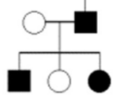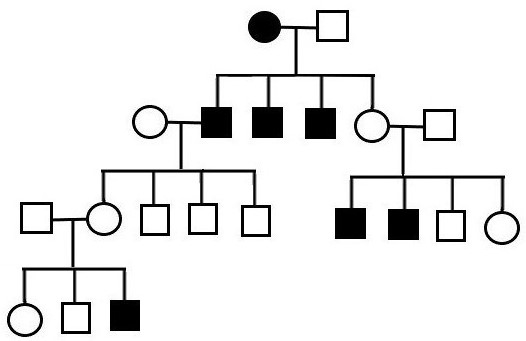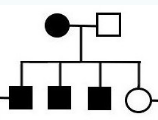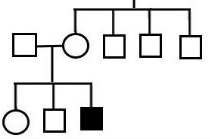What type of inheritance pattern is shown in the following pedigree (individuals with the phenotype are shown in black)?

Answer:
Remember that when the disease doesn’t skip generations, the disease will be dominant. In our case, the number of males and females is equal so sex-linked is unlikely.
For the sake of practice let’s try to analyze every individual on the list
First-generation:
Because not all of their kids are sick, we can assume that both of them are heterozygotic.
Second-generation
Healthy individuals can’t have the allele, while the sick individual might have gotten 1 or 2 defective alleles from their parents who are both heterozygous! However, based on generation 3, we can see that not all of the kids of the sick male are affected, which means that he must be heterozygous, while for the female in the 2nd generation we can’t really determine.
Can it be an X-linked dominant disease?
Remember that X-linked dominant means that boys can’t get the allele from a sick father, just the mother. The pedigree shows a boy and a girl with the disease, making it autosomal.

Third-generation:
As you can see, the third generation has only a single parent with the dominant disease. We already established that the father is heterozygous, which means that the kids must be heterozygous as well.
What type of inheritance pattern is shown in the following pedigree (individuals with the phenotype are shown in black)?

Answer:
You should recognize the pattern in the picture as a recessive disease. We can see that there is an entire generation that is completely healthy - something that is very unlikely to occur in dominant diseases
Assuming it is a recessive disorder, the parents in the 2nd generation of the third generation must be carriers as they are both healthy but have a sick child, remember the pattern!

What type of inheritance pattern is shown in the following pedigree (individuals with the phenotype are shown in black)?

Answer:
From the picture, you can recognize that there are many sick males and one sick female from the oldest generation. We also recognize that the disease skips generations (which is not possible for autosomal dominance to occur in this case), so we can conclude that it seems like a recessive disease. But is it sex-linked or autosomal? Let’s analyze the pedigree:
If it’s autosomal recessive, the mother in the first generation must be homozygous, and the father must be a carrier.

For the second generation, the sick female can be either homozygous or heterozygous, as it seems all of the kids are healthy, but one of them is undoubtedly a carrier (the mother in the third generation)

And while not likely, the father may also be a carrier.
Is it X-linked recessive?
If it was X-linked recessive, it means that the mother in the first generation is homozygous, which means all of her boys will have the condition as they only have a single X chromosome which they get from the mother.

If the mother is healthy in the next generation, we should expect all kids to be healthy. The girls will have 2 X chromosomes, one will be healthy, and the boys will certainly get a healthy chromosome from the mother.

Although the girls will be healthy, they will all be carriers of the recessive allele, which we can see in the last family, as a 50-50 percent chance that their boys will get a disease X-chromosome from the mother.
It is more likely, therefore, that the condition is X-linked recessive.